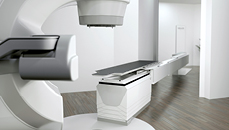
gKteso develops 6D-Robotic-Couch for linear accelerators
June 10, 2016
More comfort, higher safety, faster cycle times and more time for the patient
Radiation of cancer patients has become an important and wide-spread therapeutic option. Of particular importance here is medical experience, a great deal of tact and skill as well as best possible patient positioning. gKteso has developed the Radiotherapy Patient System RPS base, a 6D-Robotic-Couch for radiotherapy with linear accelerators, including latest technology for radiation as optimally as possible.
The patient platform is electronically controlled and does not require unnecessary corrections, due to stored patient data and its capabil-ity to re-approach the initially defined positioning at the touch of a button. “The flexible mobility of the platform, ensured by its six de-grees of freedom, is another quality feature of RPS“, explains Guido Kübler, Managing Director of gKteso.
Patient positioning from head to pelvis at the touch of a button
A patient can be optimally aligned and fixed from head to pelvis, as the patient platform is compatible with all fixation aids (add-ons). By means of dynamic tracking procedure, the patient platform corrects even organ movements automatically. In this tracking procedure, the position and movement of an organ is exactly determined by an internal or external marker, continuously conveying these data to the patient platform for any correction. “This is how pinpoint radio-therapy of the defined tissue is ensured”, Kübler emphasizes. It is necessary, inter alia, in treatments of prostate tumors, where the bowel movements constantly change the position of the diseased organ.
Central point of any rotational movement is the isocenter, which substantially facilitates operation. The patient platform, featuring high rigidity, is prepared for dynamic corrections. Further ad-vantage: Older linear accelerators can be upgraded with RPS as well. RPS base is adjustable in height from 64 to 151 cm (25” to 59”) at a velocity of zero to 50 mm (0 to 2”) per second. The margin provided in the lateral alignment is of up to plus/minus 25 cm (+/-10”) and in the length of up to plus/minus 57 cm (+/- 22”) at 0 to 80 mm (0-3”) per second. Another advantage is the large adjustment angle of up to five degrees in any direction.
RFID-Reader reads in patient data
Patient data as well as all data of applied supporting aids are read in by the integrated RFID-Reader, providing these for further soft-ware systems, for example, for documentation of the treatment. This makes preparation for radiotherapy verifiable. „Since data no longer need to be recorded manually, also documentation is facili-tated“, as Kübler describes this essential bonus for both clinics and radiotherapy centers. Last but not least, it will have a positive effect on expenses. RPS also meets and exceeds the safety require-ments, due to this technical feature.
Up to three patients are prepared for radiotherapy
The RPS extended model, an expanded system of the 6D-Robotic-Couch, allows serial, comfortable and fast radiotherapy with linear accelerator. Here, up to three patients can be simultaneously pre-pared and fixed for radiotherapy in separate rooms. Cost savings of more than 55% can be achieved. Aside from increased cycle times, RPS extended provides the advantage of reducing the time pres-sure posed on medical technology assistants. “Time saved in treatment gives room for personal attention to the patient and posi-tively affects the irradiation process“, Kübler states. This may rep-resent an essential unique selling proposition for clinical radiothera-py centers that are increasingly exposed to an intense competitive situation.
In RPS extended, satellite arms gently move the patient to the sys-tem in order to be conveyed to the 6D-Robotic-Couch (RPS base) of the linear accelerator. This is where the medical technology as-sistant (MTA) reviews the fine tunings on the patient. As soon as radiotherapy is completed, RPS base will convey the patient back to RPS extended. Once back in the anteroom, the patient may leave the patient platform.
Compatible with all add-ons
Since radiotherapy, as for example in the head and neck area, re-quires specific fixation by means of masks in order to protect sensi-tive, adjacent organs such as salivary glands, eyes, brain and spi-nal cord from being unnecessarily strained, the patient platform by gKteso is prepared for all current add-ons. Vacuum mattresses as well as many other modular positioning aids may be attached to the Radiotherapy Patient System RPS extended.
In 50 to 60 percent of all patients with cancerous disease, radio-therapy is part of the therapy plan in the course of their treatment. One of several methods is irradiation with a linear accelerator. gKteso GmbH is a mid-size company located in Bobingen near Augsburg, Germany, specializing in the development of RPS (Radiotherapy Patient System).
About 25 years ago, Guido Kübler, mechanical engineer, founder and Managing Director of the com-pany, started with the development and manufacturing of electroni-cally controlled patient platforms for various applications. In distribu-tion, the company is classic OEM to distinguished international partners.
